Health Systems and Economics: Columbia Healthcare Case Study Analysis
VerifiedAdded on 2022/09/17
|7
|1375
|21
Case Study
AI Summary
This case study examines the healthcare system in Columbia, focusing on its funding mechanisms, performance indicators, and economic analyses. Columbia's healthcare market is the third largest in Latin America, with funding primarily from taxes and financial surpluses. The study analyzes healthcare expenditure, considering factors like labor supply and productivity. It explores the roles of both private and public healthcare services, highlighting affordability and accessibility. The analysis includes cost-benefit and cost-effectiveness evaluations, emphasizing the need for improved training and development in the healthcare sector. The document also provides statistics on neonatal mortality, antenatal care, and outlines how economic levers can be used to improve healthcare facilities. The study concludes with a discussion on the importance of innovative financing methods and the impact of demographic trends on healthcare management.
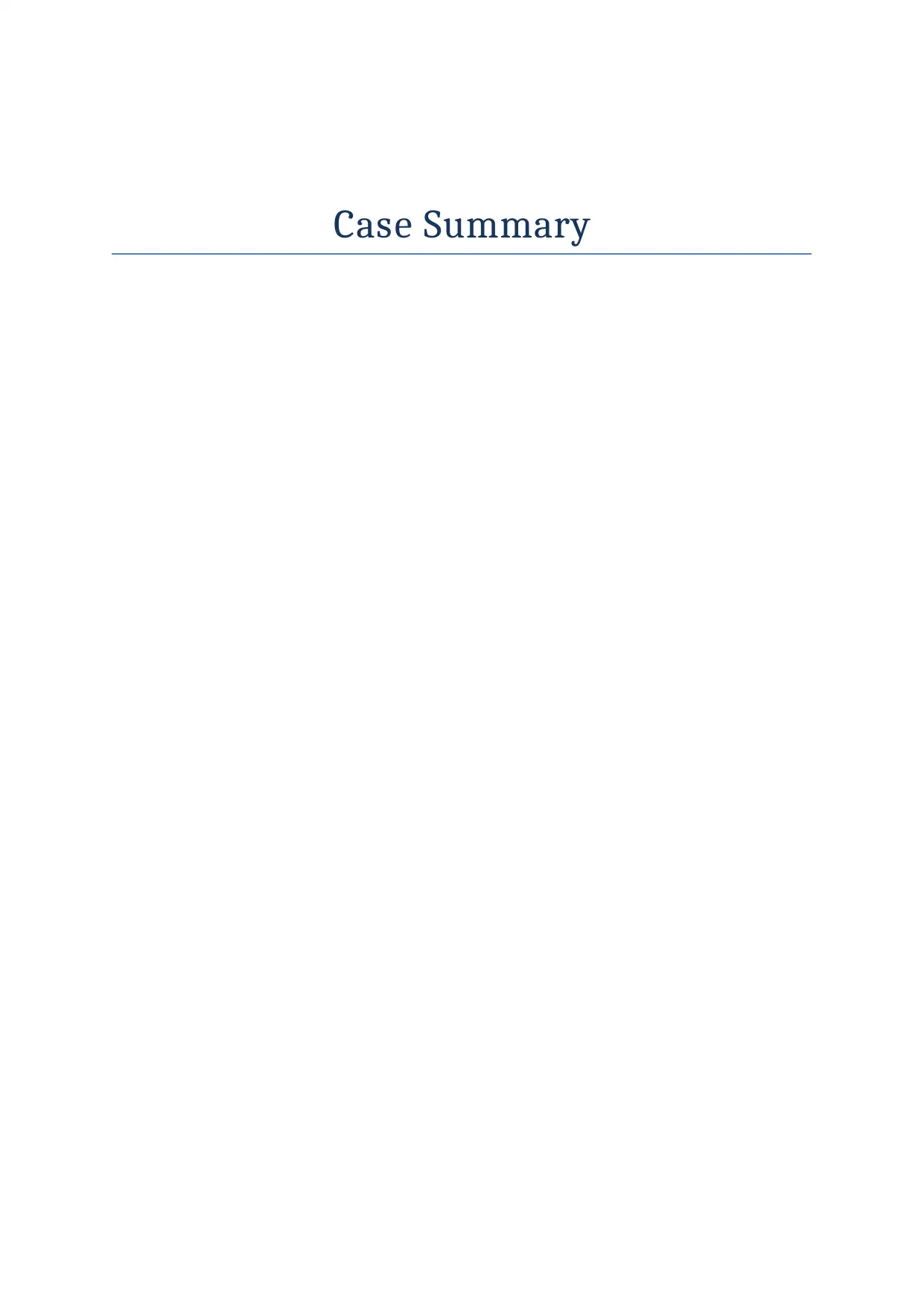
Case Summary
Paraphrase This Document
Need a fresh take? Get an instant paraphrase of this document with our AI Paraphraser
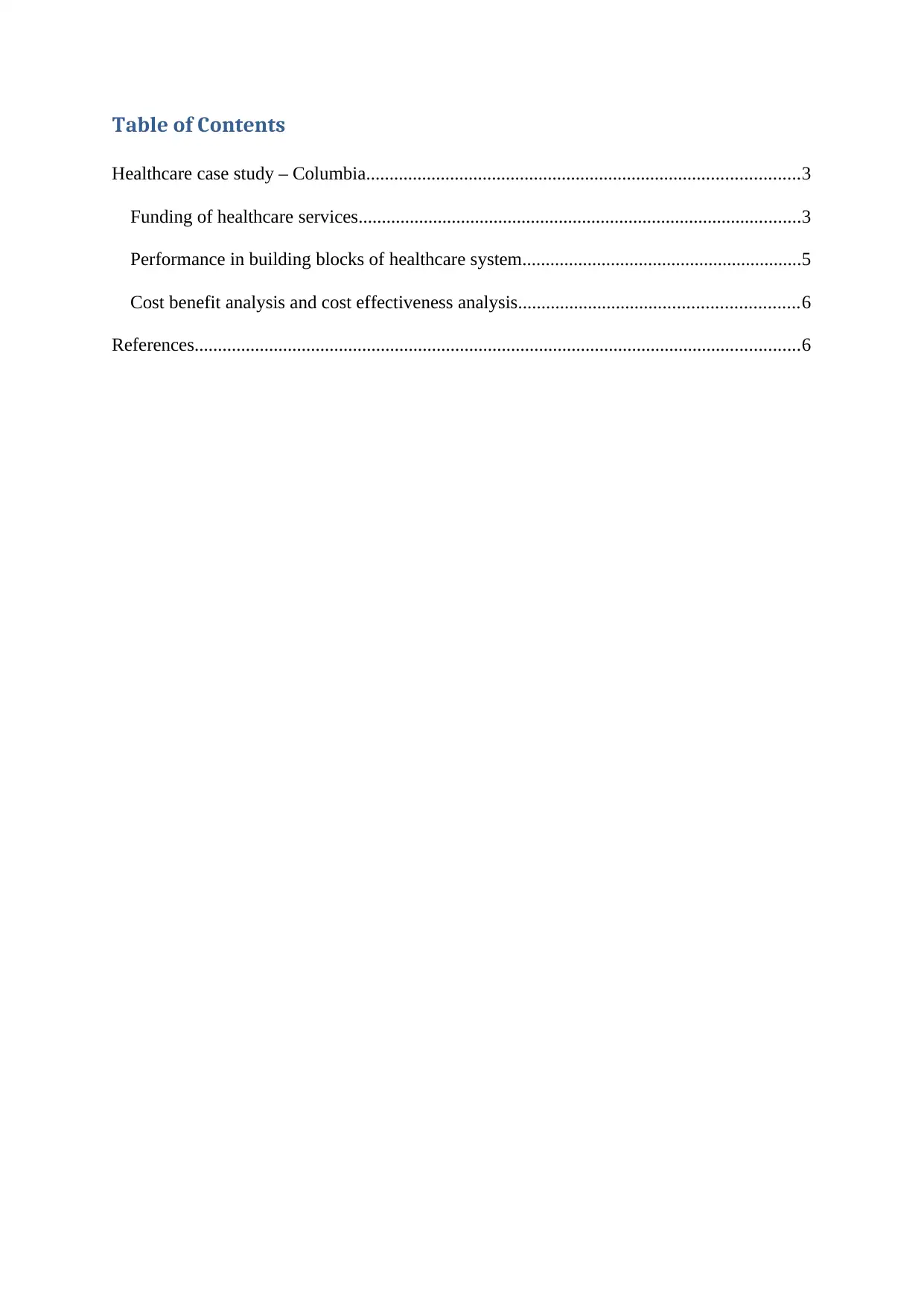
Table of Contents
Healthcare case study – Columbia.............................................................................................3
Funding of healthcare services...............................................................................................3
Performance in building blocks of healthcare system............................................................5
Cost benefit analysis and cost effectiveness analysis............................................................6
References..................................................................................................................................6
Healthcare case study – Columbia.............................................................................................3
Funding of healthcare services...............................................................................................3
Performance in building blocks of healthcare system............................................................5
Cost benefit analysis and cost effectiveness analysis............................................................6
References..................................................................................................................................6
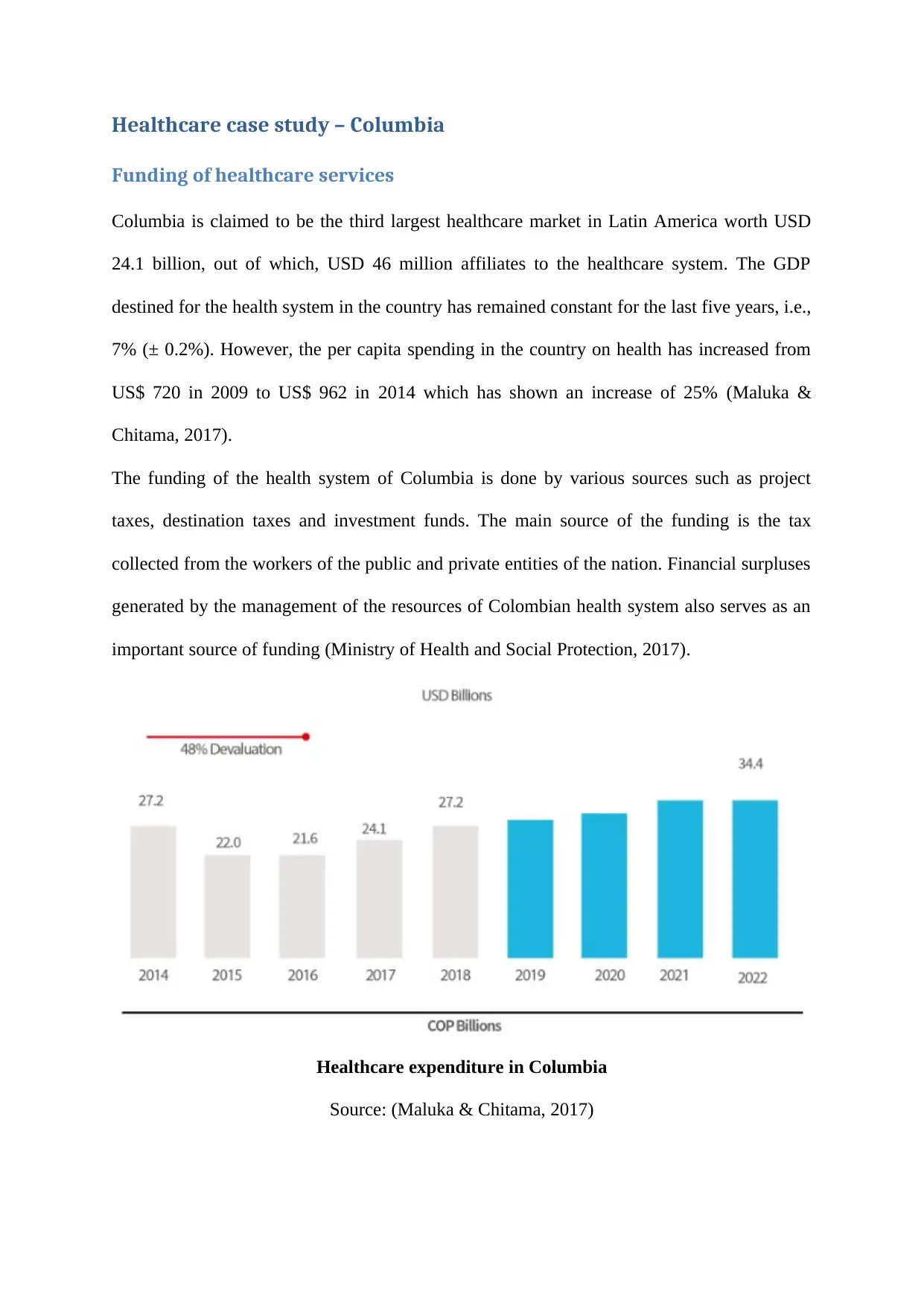
Healthcare case study – Columbia
Funding of healthcare services
Columbia is claimed to be the third largest healthcare market in Latin America worth USD
24.1 billion, out of which, USD 46 million affiliates to the healthcare system. The GDP
destined for the health system in the country has remained constant for the last five years, i.e.,
7% (± 0.2%). However, the per capita spending in the country on health has increased from
US$ 720 in 2009 to US$ 962 in 2014 which has shown an increase of 25% (Maluka &
Chitama, 2017).
The funding of the health system of Columbia is done by various sources such as project
taxes, destination taxes and investment funds. The main source of the funding is the tax
collected from the workers of the public and private entities of the nation. Financial surpluses
generated by the management of the resources of Colombian health system also serves as an
important source of funding (Ministry of Health and Social Protection, 2017).
Healthcare expenditure in Columbia
Source: (Maluka & Chitama, 2017)
Funding of healthcare services
Columbia is claimed to be the third largest healthcare market in Latin America worth USD
24.1 billion, out of which, USD 46 million affiliates to the healthcare system. The GDP
destined for the health system in the country has remained constant for the last five years, i.e.,
7% (± 0.2%). However, the per capita spending in the country on health has increased from
US$ 720 in 2009 to US$ 962 in 2014 which has shown an increase of 25% (Maluka &
Chitama, 2017).
The funding of the health system of Columbia is done by various sources such as project
taxes, destination taxes and investment funds. The main source of the funding is the tax
collected from the workers of the public and private entities of the nation. Financial surpluses
generated by the management of the resources of Colombian health system also serves as an
important source of funding (Ministry of Health and Social Protection, 2017).
Healthcare expenditure in Columbia
Source: (Maluka & Chitama, 2017)
⊘ This is a preview!⊘
Do you want full access?
Subscribe today to unlock all pages.

Trusted by 1+ million students worldwide
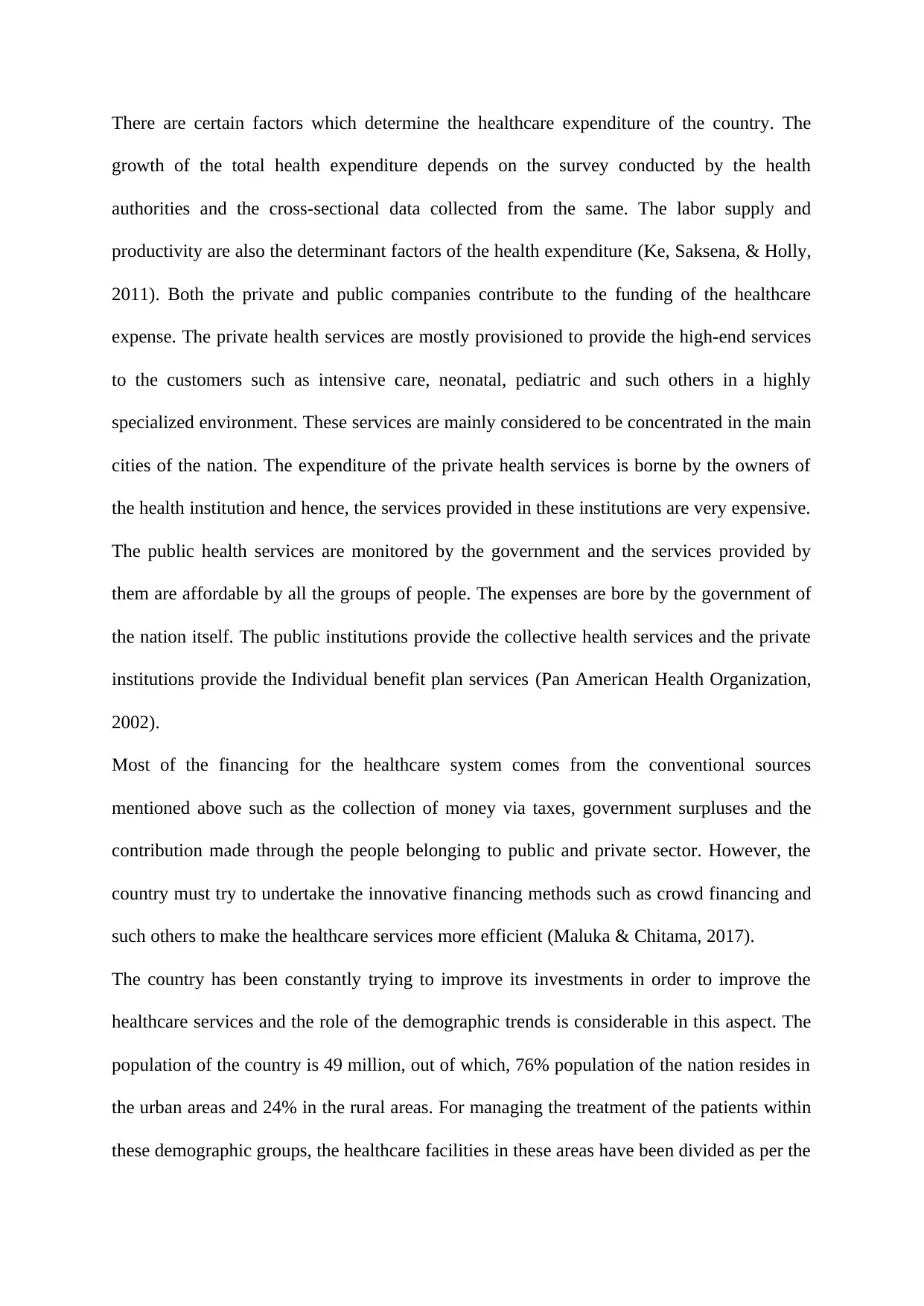
There are certain factors which determine the healthcare expenditure of the country. The
growth of the total health expenditure depends on the survey conducted by the health
authorities and the cross-sectional data collected from the same. The labor supply and
productivity are also the determinant factors of the health expenditure (Ke, Saksena, & Holly,
2011). Both the private and public companies contribute to the funding of the healthcare
expense. The private health services are mostly provisioned to provide the high-end services
to the customers such as intensive care, neonatal, pediatric and such others in a highly
specialized environment. These services are mainly considered to be concentrated in the main
cities of the nation. The expenditure of the private health services is borne by the owners of
the health institution and hence, the services provided in these institutions are very expensive.
The public health services are monitored by the government and the services provided by
them are affordable by all the groups of people. The expenses are bore by the government of
the nation itself. The public institutions provide the collective health services and the private
institutions provide the Individual benefit plan services (Pan American Health Organization,
2002).
Most of the financing for the healthcare system comes from the conventional sources
mentioned above such as the collection of money via taxes, government surpluses and the
contribution made through the people belonging to public and private sector. However, the
country must try to undertake the innovative financing methods such as crowd financing and
such others to make the healthcare services more efficient (Maluka & Chitama, 2017).
The country has been constantly trying to improve its investments in order to improve the
healthcare services and the role of the demographic trends is considerable in this aspect. The
population of the country is 49 million, out of which, 76% population of the nation resides in
the urban areas and 24% in the rural areas. For managing the treatment of the patients within
these demographic groups, the healthcare facilities in these areas have been divided as per the
growth of the total health expenditure depends on the survey conducted by the health
authorities and the cross-sectional data collected from the same. The labor supply and
productivity are also the determinant factors of the health expenditure (Ke, Saksena, & Holly,
2011). Both the private and public companies contribute to the funding of the healthcare
expense. The private health services are mostly provisioned to provide the high-end services
to the customers such as intensive care, neonatal, pediatric and such others in a highly
specialized environment. These services are mainly considered to be concentrated in the main
cities of the nation. The expenditure of the private health services is borne by the owners of
the health institution and hence, the services provided in these institutions are very expensive.
The public health services are monitored by the government and the services provided by
them are affordable by all the groups of people. The expenses are bore by the government of
the nation itself. The public institutions provide the collective health services and the private
institutions provide the Individual benefit plan services (Pan American Health Organization,
2002).
Most of the financing for the healthcare system comes from the conventional sources
mentioned above such as the collection of money via taxes, government surpluses and the
contribution made through the people belonging to public and private sector. However, the
country must try to undertake the innovative financing methods such as crowd financing and
such others to make the healthcare services more efficient (Maluka & Chitama, 2017).
The country has been constantly trying to improve its investments in order to improve the
healthcare services and the role of the demographic trends is considerable in this aspect. The
population of the country is 49 million, out of which, 76% population of the nation resides in
the urban areas and 24% in the rural areas. For managing the treatment of the patients within
these demographic groups, the healthcare facilities in these areas have been divided as per the
Paraphrase This Document
Need a fresh take? Get an instant paraphrase of this document with our AI Paraphraser
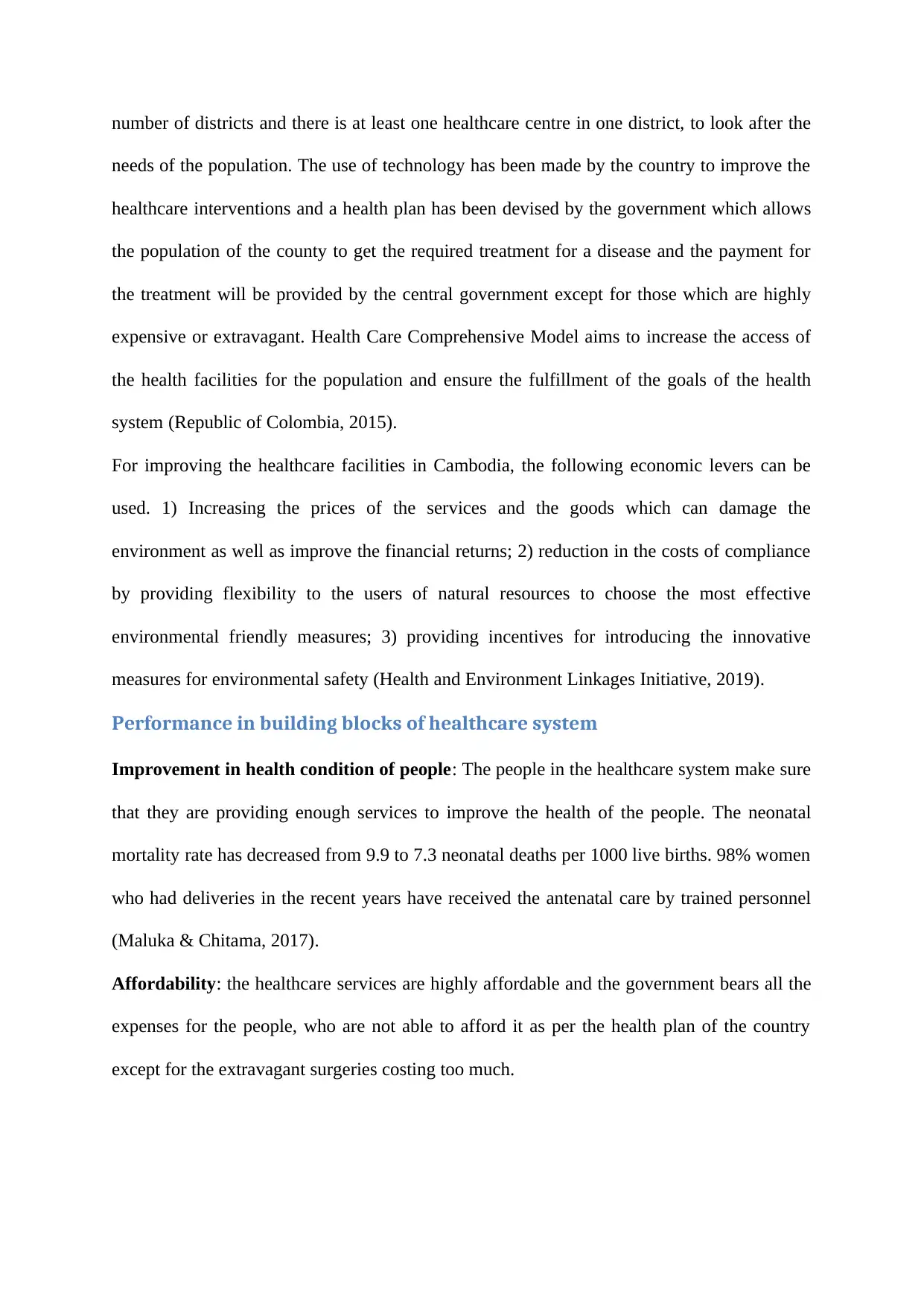
number of districts and there is at least one healthcare centre in one district, to look after the
needs of the population. The use of technology has been made by the country to improve the
healthcare interventions and a health plan has been devised by the government which allows
the population of the county to get the required treatment for a disease and the payment for
the treatment will be provided by the central government except for those which are highly
expensive or extravagant. Health Care Comprehensive Model aims to increase the access of
the health facilities for the population and ensure the fulfillment of the goals of the health
system (Republic of Colombia, 2015).
For improving the healthcare facilities in Cambodia, the following economic levers can be
used. 1) Increasing the prices of the services and the goods which can damage the
environment as well as improve the financial returns; 2) reduction in the costs of compliance
by providing flexibility to the users of natural resources to choose the most effective
environmental friendly measures; 3) providing incentives for introducing the innovative
measures for environmental safety (Health and Environment Linkages Initiative, 2019).
Performance in building blocks of healthcare system
Improvement in health condition of people: The people in the healthcare system make sure
that they are providing enough services to improve the health of the people. The neonatal
mortality rate has decreased from 9.9 to 7.3 neonatal deaths per 1000 live births. 98% women
who had deliveries in the recent years have received the antenatal care by trained personnel
(Maluka & Chitama, 2017).
Affordability: the healthcare services are highly affordable and the government bears all the
expenses for the people, who are not able to afford it as per the health plan of the country
except for the extravagant surgeries costing too much.
needs of the population. The use of technology has been made by the country to improve the
healthcare interventions and a health plan has been devised by the government which allows
the population of the county to get the required treatment for a disease and the payment for
the treatment will be provided by the central government except for those which are highly
expensive or extravagant. Health Care Comprehensive Model aims to increase the access of
the health facilities for the population and ensure the fulfillment of the goals of the health
system (Republic of Colombia, 2015).
For improving the healthcare facilities in Cambodia, the following economic levers can be
used. 1) Increasing the prices of the services and the goods which can damage the
environment as well as improve the financial returns; 2) reduction in the costs of compliance
by providing flexibility to the users of natural resources to choose the most effective
environmental friendly measures; 3) providing incentives for introducing the innovative
measures for environmental safety (Health and Environment Linkages Initiative, 2019).
Performance in building blocks of healthcare system
Improvement in health condition of people: The people in the healthcare system make sure
that they are providing enough services to improve the health of the people. The neonatal
mortality rate has decreased from 9.9 to 7.3 neonatal deaths per 1000 live births. 98% women
who had deliveries in the recent years have received the antenatal care by trained personnel
(Maluka & Chitama, 2017).
Affordability: the healthcare services are highly affordable and the government bears all the
expenses for the people, who are not able to afford it as per the health plan of the country
except for the extravagant surgeries costing too much.
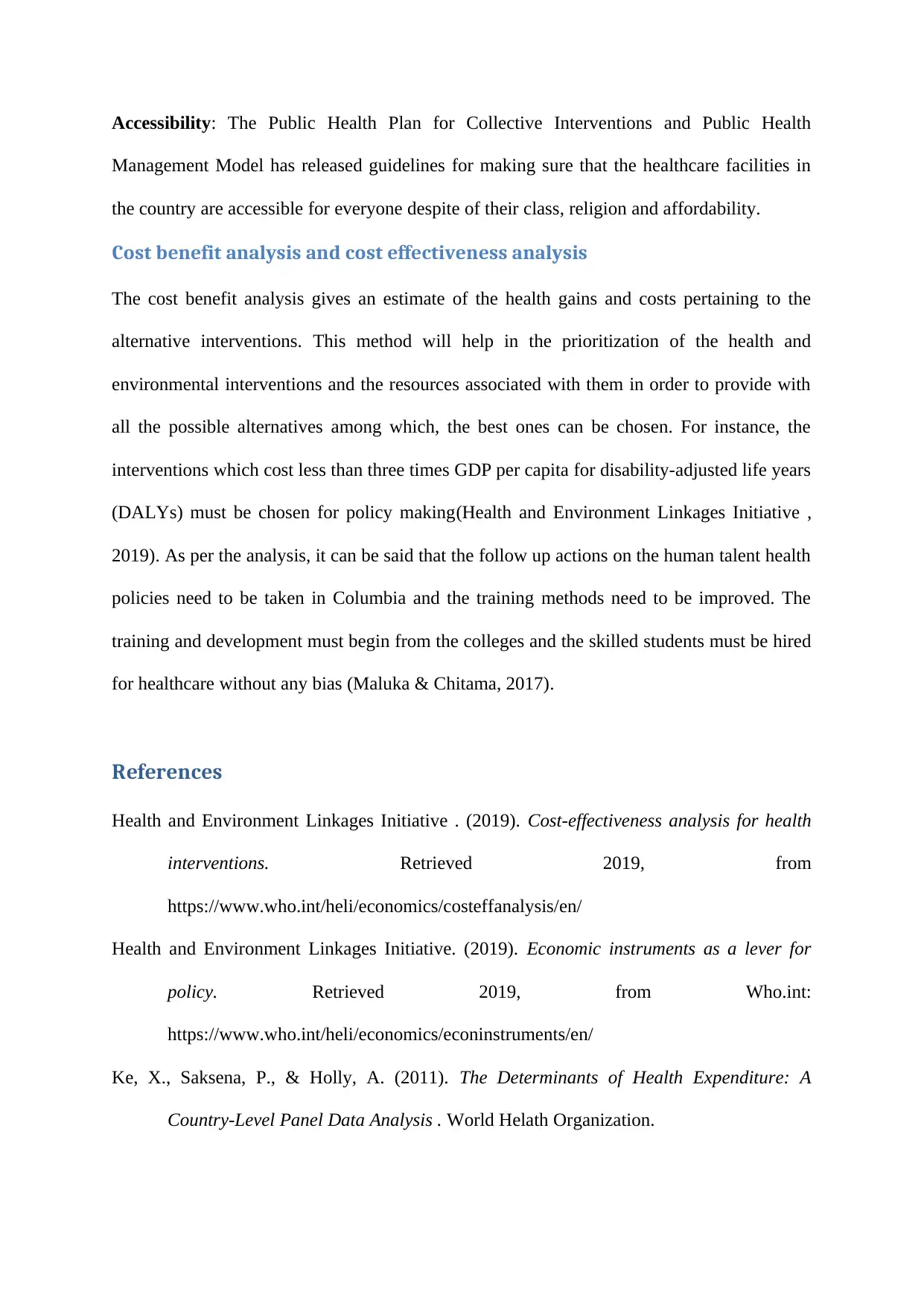
Accessibility: The Public Health Plan for Collective Interventions and Public Health
Management Model has released guidelines for making sure that the healthcare facilities in
the country are accessible for everyone despite of their class, religion and affordability.
Cost benefit analysis and cost effectiveness analysis
The cost benefit analysis gives an estimate of the health gains and costs pertaining to the
alternative interventions. This method will help in the prioritization of the health and
environmental interventions and the resources associated with them in order to provide with
all the possible alternatives among which, the best ones can be chosen. For instance, the
interventions which cost less than three times GDP per capita for disability-adjusted life years
(DALYs) must be chosen for policy making(Health and Environment Linkages Initiative ,
2019). As per the analysis, it can be said that the follow up actions on the human talent health
policies need to be taken in Columbia and the training methods need to be improved. The
training and development must begin from the colleges and the skilled students must be hired
for healthcare without any bias (Maluka & Chitama, 2017).
References
Health and Environment Linkages Initiative . (2019). Cost-effectiveness analysis for health
interventions. Retrieved 2019, from
https://www.who.int/heli/economics/costeffanalysis/en/
Health and Environment Linkages Initiative. (2019). Economic instruments as a lever for
policy. Retrieved 2019, from Who.int:
https://www.who.int/heli/economics/econinstruments/en/
Ke, X., Saksena, P., & Holly, A. (2011). The Determinants of Health Expenditure: A
Country-Level Panel Data Analysis . World Helath Organization.
Management Model has released guidelines for making sure that the healthcare facilities in
the country are accessible for everyone despite of their class, religion and affordability.
Cost benefit analysis and cost effectiveness analysis
The cost benefit analysis gives an estimate of the health gains and costs pertaining to the
alternative interventions. This method will help in the prioritization of the health and
environmental interventions and the resources associated with them in order to provide with
all the possible alternatives among which, the best ones can be chosen. For instance, the
interventions which cost less than three times GDP per capita for disability-adjusted life years
(DALYs) must be chosen for policy making(Health and Environment Linkages Initiative ,
2019). As per the analysis, it can be said that the follow up actions on the human talent health
policies need to be taken in Columbia and the training methods need to be improved. The
training and development must begin from the colleges and the skilled students must be hired
for healthcare without any bias (Maluka & Chitama, 2017).
References
Health and Environment Linkages Initiative . (2019). Cost-effectiveness analysis for health
interventions. Retrieved 2019, from
https://www.who.int/heli/economics/costeffanalysis/en/
Health and Environment Linkages Initiative. (2019). Economic instruments as a lever for
policy. Retrieved 2019, from Who.int:
https://www.who.int/heli/economics/econinstruments/en/
Ke, X., Saksena, P., & Holly, A. (2011). The Determinants of Health Expenditure: A
Country-Level Panel Data Analysis . World Helath Organization.
⊘ This is a preview!⊘
Do you want full access?
Subscribe today to unlock all pages.

Trusted by 1+ million students worldwide
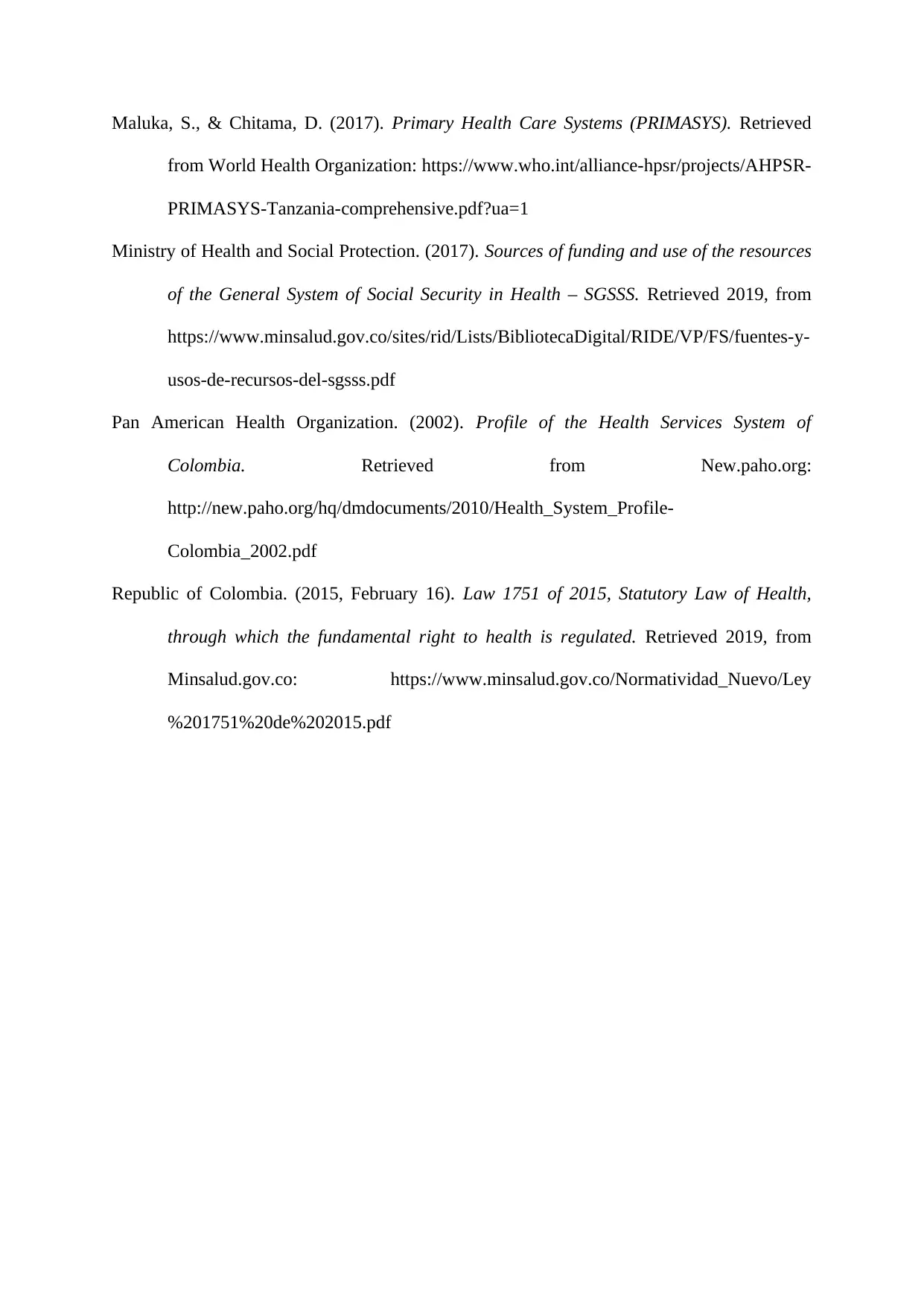
Maluka, S., & Chitama, D. (2017). Primary Health Care Systems (PRIMASYS). Retrieved
from World Health Organization: https://www.who.int/alliance-hpsr/projects/AHPSR-
PRIMASYS-Tanzania-comprehensive.pdf?ua=1
Ministry of Health and Social Protection. (2017). Sources of funding and use of the resources
of the General System of Social Security in Health – SGSSS. Retrieved 2019, from
https://www.minsalud.gov.co/sites/rid/Lists/BibliotecaDigital/RIDE/VP/FS/fuentes-y-
usos-de-recursos-del-sgsss.pdf
Pan American Health Organization. (2002). Profile of the Health Services System of
Colombia. Retrieved from New.paho.org:
http://new.paho.org/hq/dmdocuments/2010/Health_System_Profile-
Colombia_2002.pdf
Republic of Colombia. (2015, February 16). Law 1751 of 2015, Statutory Law of Health,
through which the fundamental right to health is regulated. Retrieved 2019, from
Minsalud.gov.co: https://www.minsalud.gov.co/Normatividad_Nuevo/Ley
%201751%20de%202015.pdf
from World Health Organization: https://www.who.int/alliance-hpsr/projects/AHPSR-
PRIMASYS-Tanzania-comprehensive.pdf?ua=1
Ministry of Health and Social Protection. (2017). Sources of funding and use of the resources
of the General System of Social Security in Health – SGSSS. Retrieved 2019, from
https://www.minsalud.gov.co/sites/rid/Lists/BibliotecaDigital/RIDE/VP/FS/fuentes-y-
usos-de-recursos-del-sgsss.pdf
Pan American Health Organization. (2002). Profile of the Health Services System of
Colombia. Retrieved from New.paho.org:
http://new.paho.org/hq/dmdocuments/2010/Health_System_Profile-
Colombia_2002.pdf
Republic of Colombia. (2015, February 16). Law 1751 of 2015, Statutory Law of Health,
through which the fundamental right to health is regulated. Retrieved 2019, from
Minsalud.gov.co: https://www.minsalud.gov.co/Normatividad_Nuevo/Ley
%201751%20de%202015.pdf
1 out of 7
Related Documents
Your All-in-One AI-Powered Toolkit for Academic Success.
+13062052269
info@desklib.com
Available 24*7 on WhatsApp / Email
![[object Object]](/_next/static/media/star-bottom.7253800d.svg)
Unlock your academic potential
Copyright © 2020–2025 A2Z Services. All Rights Reserved. Developed and managed by ZUCOL.





